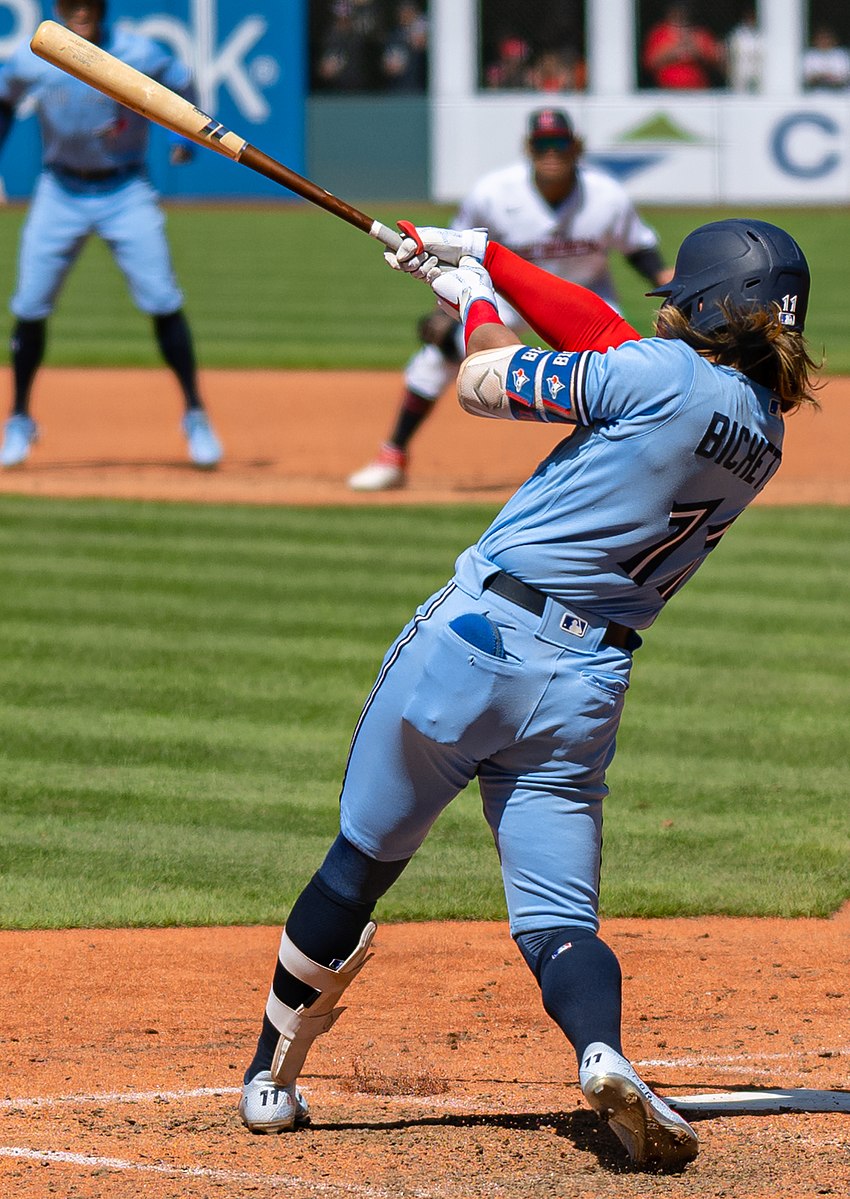Bo Bichette is Overcoming His Season-Long Woes with Red-Hot September
It’s no secret that the 2022 season has been disappointing for Bo Bichette, who’s struggled to take the next step in his career. But he’s turning it on when it matters most down the stretch.
After serving as a five-win player last season, everyone expected Bichette to build off that performance this season, positioning himself amongst the sport’s top-tier shortstops. And while the 24-year-old has been productive at times, his results haven’t met his high expectations.
Or least, they hadn’t until the calendar flipped to September.
Bichette started miserably out of the gate, hitting .213/.237/.298 with a 50 wRC+ score across 97 plate appearances in April. Amid his slow start, the fanbase quickly criticized the Toronto Blue Jays shortstop, demanding his performance improve.
And it did, albeit briefly. The right-hander found his footing in mid-May and was scorching hot for roughly four weeks, hitting .314/.369/.598 with seven home runs, 18 RBIs and a 175 wRC+ during that span.
With that productive stretch, Bichette quickly improved his season results, raising his wRC+ to 118 on Jun. 12, making him 18 percent better than league average. Unfortunately, his offensive woes returned shortly after, capping off an underwhelming first half.
The second-round pick from 2016 entered the All-Star break with a disappointing .257/.302/.418 slash line and 105 wRC+ in 411 plate appearances. Those were well below what fans were expecting from the 2021 All-Star, and he too, expected more from himself.
Sadly, Bichette’s production remained inconsistent out of the break, causing the pressure to build leading into the final five weeks of the regular season.
Up to that point, the 6-foot shortstop hadn’t played his best baseball, with his wRC+ for the season sitting at 106 on Aug. 31. That still put him slightly above league average, although everyone knew he was capable of more.
Amid a season full of frustrations, things finally clicked for the young phenom during his team’s early-September road trip to Pittsburgh. He didn’t break out immediately, but it quickly became evident that type of run wasn’t far behind.
In three games versus the Pirates, Bichette went 6-for-12 with three extra-base hits (two doubles, one home run) and five RBIs, including a game-winning three-run double in Game 2 of the series. And he hasn’t cooled off since then.
Since Sep. 1, the young righty has hit .484/.515/.984 with seven round-trippers, 22 RBIs and a monstrous 326 wRC+ through 68 plate appearances. He also owns a .490 BABIP, .500 ISO and .626 wOBA.
No other hitter has been hotter than Bichette as he leads the majors in fWAR (2.0), wRC+, AVG, SLG, wOBA and RBIs this month, according to FanGraphs. His seven home runs are tied with Mike Trout and Daulton Varsho for first during this span.
Toronto has won 11 of its 15 games in September, which wouldn’t have been possible if not for Bichette’s hot streak. The team has needed every bit of his offensive surge, especially with Vladimir Guerrero Jr. battling ground-ball issues and George Springer dealing with an elbow injury.
It’s the type of stretch that was tough to come by across the first five months of the season. So why is it transpiring now? Well, a lot of it involves the quality of Bichette’s at-bats.
For much of the season, the former top prospect was easily susceptible to strikeouts, resulting in a 24.3 percent clip prior to Sep. 1. One of his biggest weaknesses was his willingness to swing at pitches beyond the strike zone, producing a 38.7 percent chase rate. Both of which ranked in the bottom 10 among qualified big-league shortstops.
Bichette has improved both metrics in September, though, registering an 11.8 percent strikeout rate and 36.0 percent chase rate. As his swings and misses have decreased, his effectiveness as a run producer has increased.
Being aggressive is part of Bichette’s DNA. It comes with the territory of being such a terrific two-strike hitter, which are situations where he’s thrived as of late.
Pre-Sep. 1, the second-generation star slashed .145/.204/.235 with a 24 wRC+ and a 49.3 percent strikeout rate during two-strike counts. Post-Sep. 1, however, he features a .379/.400/.690 slash line, 211 wRC+ and 26.7 percent strikeout rate.
No longer is Bichette offering at bad pitches outside the zone, leading to non-productive at-bats once the count reaches two strikes. Instead, he’s taking those tough pitches and forcing pitchers back into the zone, allowing him to create damage against them.
That’s something Blue Jays fans have been waiting for all season, and it’s an approach that should help Bichette sustain these results the rest of the way. If successful, it could lead to a very productive postseason.
With his September surge, the Orlando, Fla., native has boosted his position among the game’s top shortstops, which didn’t seem possible a few months ago. Now, he’s near the top in most offensive categories.
Overall, Bichette currently ranks second in SLG (.482), third in RBIs (88), tied for third in home runs (24), fourth in wOBA (.349) and wRC+ (130), fifth in AVG (.285) and sixth in fWAR (4.4).
There aren’t enough games remaining for Bichette to completely overcome his previous woes, however, he’s not far off last season’s totals. That’s not where he wants to be, obviously, but it’s progress.
Considering how poor his offensive numbers were through the first five months of the season, finishing similar to his 2021 performance would be pretty impressive. It’d allow him to salvage, to some degree, what’s been a fairly frustrating campaign.
But if Bichette stays hot into the playoffs and leads the Blue Jays deep in October, most fans can probably sleep easier over his previous season-long shortcomings.
-Thomas Hall
Twitter: @ThomasHall85
Photo: Erik Drost. This file is licensed under the Creative Commons Attribution 2.0 Generic license.

